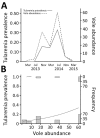Density-Dependent Prevalence of Francisella tularensis in Fluctuating Vole Populations, Northwestern Spain
- PMID: 28726608
- PMCID: PMC5547778
- DOI: 10.3201/eid2308.161194
Density-Dependent Prevalence of Francisella tularensis in Fluctuating Vole Populations, Northwestern Spain
Abstract
Tularemia in humans in northwestern Spain is associated with increases in vole populations. Prevalence of infection with Francisella tularensis in common voles increased to 33% during a vole population fluctuation. This finding confirms that voles are spillover agents for zoonotic outbreaks. Ecologic interactions associated with tularemia prevention should be considered.
Keywords: Francisella tularensis; Spain; bacteria; density-dependent prevalence; fluctuating populations; outbreaks; prevalence; tularemia; voles; wildlife; zoonoses.
Figures

References
-
- Walton L, Marion G, Davidson RS, White PCL, Smith LA, Gavier-Widen D, et al. The ecology of wildlife disease surveillance: demographic and prevalence fluctuations undermine surveillance. J Appl Ecol. 2016;53:1460–9. 10.1111/1365-2664.12671 - DOI
-
- World Health Organization. Guidelines on tularaemia. Geneva: The Organization; 2007. [cited 2017 May 3]. http://www.who.int/iris/handle/10665/43793
MeSH terms
LinkOut - more resources
Full Text Sources
Other Literature Sources
Medical

